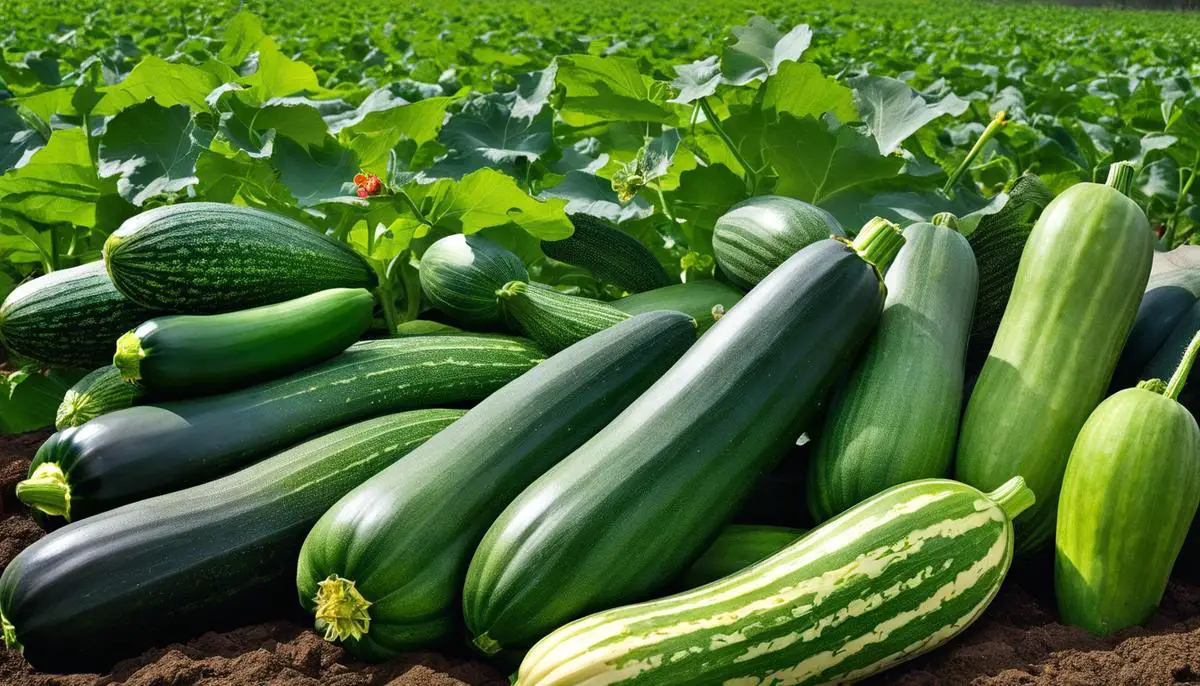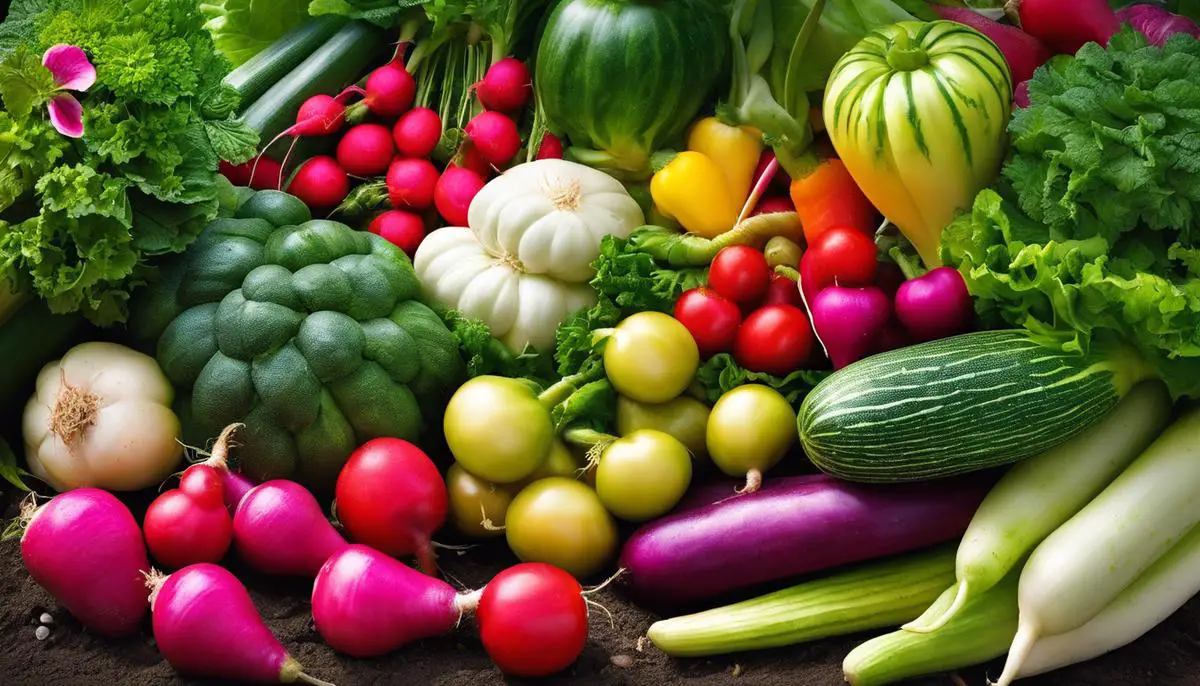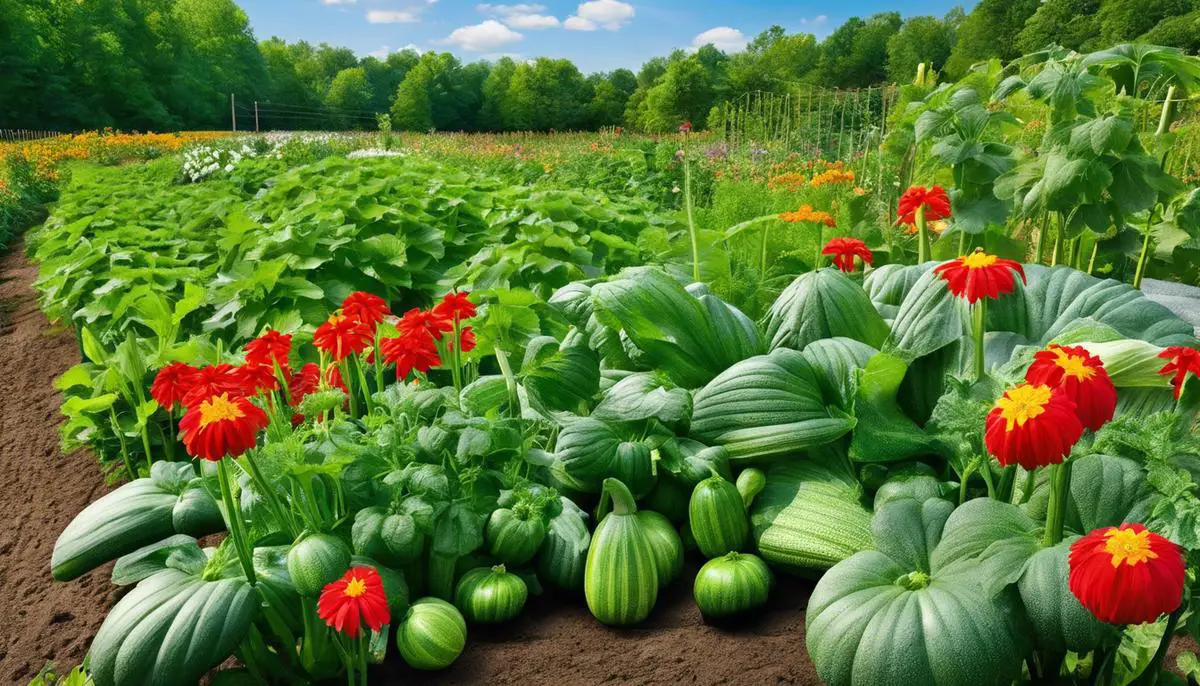Gardeners often seek ways to enhance productivity and health in their patches of green, and companion planting stands as a time-honored technique that marries science with a dab of garden folklore. When we plant zucchini, a garden favorite, we have the chance to unlock its full potential by nestling it among a carefully curated selection of plant allies. This is not only an act of optimization but an embrace of a harmonious garden ecosystem. Within this discussion, we’ll explore why pairing zucchini with the right neighbors can lead to a thriving, pest-resistant, and bountiful garden and how certain plants offer more than just companionship through a symbiosis that benefits all parties with their feet in the soil.
Benefits of Companion Planting
Gardeners, unite! Do you have a special spot in your heart for those delightfully green, versatile zucchinis? Of course! So let’s chat about boosting your beloved zucchini game with the magic of companion planting. This isn’t just about making your garden look more inviting; it’s a practical move that can lead to happier, healthier plants and even more bountiful harvests.
Reader Poll: What online courses would interest you?
First things first, why buddy up your zucchini with other plants? Think of your garden as a little ecosystem where each plant can either be a good neighbor or not-so-great one. Pairing zucchini with the right companions helps to ward off pests while also saving space. Flowers like marigolds and nasturtiums are not just pretty faces; they are known to deter pests with their strong scents, which means less work trying to control unwanted visitors. Including these vibrant blooms can mean fewer bugs munching on your zucchinis.
But it’s not just about keeping pests at bay; it’s also about nourishing the soil. Legumes, like beans and peas, are fantastic pals for zucchini. These friendly neighbors have a remarkable ability to fix nitrogen—basically, they take nitrogen from the air and turn it into a form that plants can use. This process can be particularly beneficial for nutrient-hungry vegetables like zucchini, promoting strong growth and a generous yield. So, go ahead, make some match-ups in your garden plot. Your zucchini – and your taste buds – will thank you for it!

Top Companion Plants for Zucchini
When diving into the intricacies of cultivating a thriving zucchini garden, companion planting takes center stage, and it extends far beyond just pest control and soil enrichment. An array of plants plays distinct roles, creating a harmonious environment that can aid your zucchinis to grow stronger and produce more extensively. One particularly exemplary comrade for zucchini is garlic. This pungent bulb works a double shift in the garden: it repulses aphids and other pests that could otherwise make a meal of your squash leaves, and it prevents fungal diseases, which can be the bane of many zucchini growers’ existence.
Subscribe to our newsletter!
Herbs are another genre of plants worth considering for their multifaceted benefits. Among these, basil and dill are standout companions. Planting basil around zucchini can enhance both the flavor and the growth of your squash. Additionally, basil sends out a scent that is unappealing to many insects, offering yet another layer of protection. Dill, while more commonly associated with pickling, also stands as a line of defense in the zucchini patch. It attracts beneficial predatory insects, such as wasps, who will happily feast on undesirable caterpillars and other zucchini pests.
Lastly, the relationship between zucchini and corn provides a classic example of companion planting done right. Corn stalks offer a sturdy structure that can support vining zucchini plants, facilitating vertical growth and optimizing garden space. This method of cultivation, sometimes referred to as the “Three Sisters” when beans are also integrated, is a testament to the power of strategic garden planning. This practice not only capitalizes on space but also encourages a communal boost in each plant’s odds of flourishing. As with any good companionship, the key is finding the right balance to bring out the best in everyone involved.

Plants to Avoid Near Zucchini
Venturing a bit further into the world of zucchini companion planting, it’s just as important to know which plants to keep at a distance as it is to know the friends of this squash.
Tomatoes, for instance, are a big no-no near zucchini. These two compete aggressively for the same nutrients and often attract similar pests, which can spell double trouble for gardeners.
Another less-than-ideal neighbor for zucchini is the potato. It might come as a surprise, but potatoes can increase the risk of blight—a disease that can swiftly wipe out your squash. Sharing the same soil, potatoes can also impede the growth of zucchini plants due to their extensive underground tuber system.
Steering clear of these plants is not about garden superstition, but about understanding the delicate balance of the garden ecosystem. Pacing out your plants properly ensures that your zucchini can thrive without rivals. Remembering these simple guidelines will help yield a garden that’s both visually pleasing and fruitful.

Tips for Implementing Companion Planting
Companion planting with zucchini is a technique as clever as it is practical. To enhance the effectiveness of this practice, bodyguards like radishes can come into play. These sharp-flavored roots serve an additional purpose beyond spicing up salads; they act as a trap for squash vine borers, luring these pesky insects away from the tender zucchinis. When considering timing, radishes are quick to grow and can be sown directly among the zucchini seeds. As they mature swiftly, they do their protective duty and can be harvested long before the zucchinis need more room.
While balancing the ecosystem with strategic plant partnerships, it’s also essential to consider timing and spacing for peak performance. Staggered planting has its place in the zucchini companion playbook. For staggered planting, sow seeds at intervals, allowing certain companion plants to establish themselves first. This method not only maximizes garden space throughout the growing season but can also extend the harvest period for zucchini’s companions, ensuring continuous support in pest control and nutrient provision. Careful spacing is key, ensuring that each plant has ample room to thrive without competition. This technique not only supports healthy growth but also offers easier access for garden maintenance and harvesting.
The wisdom in companion planting truly comes into focus as we zoom out to see the symphony of benefits it brings to the garden table. Once the basics are in place—using allies like radishes as frontline defenders and staggering the planting for sustained support—the zucchini patch can transform into a buzzing hub of productivity and vitality, ripe with the promise of a generous harvest. Take these steps, treasure the companionship, and watch as the garden becomes a showcase of harmony in action.

Arming ourselves with the knowledge of which plants to place side by side for mutual benefit is akin to creating a vibrant tapestry in the garden that brims with life, function, and productivity. While we navigate the planting season, these insights afford our zucchini and its companions the best chance to flourish. Remember, the pathway to a vibrant and healthy garden is not only in the seeds we sow but the relationships we foster below the canopy. Let the dance of diversity within our gardens propel us toward a season of abundance and the joys of a well-planned garden brimming with life.

